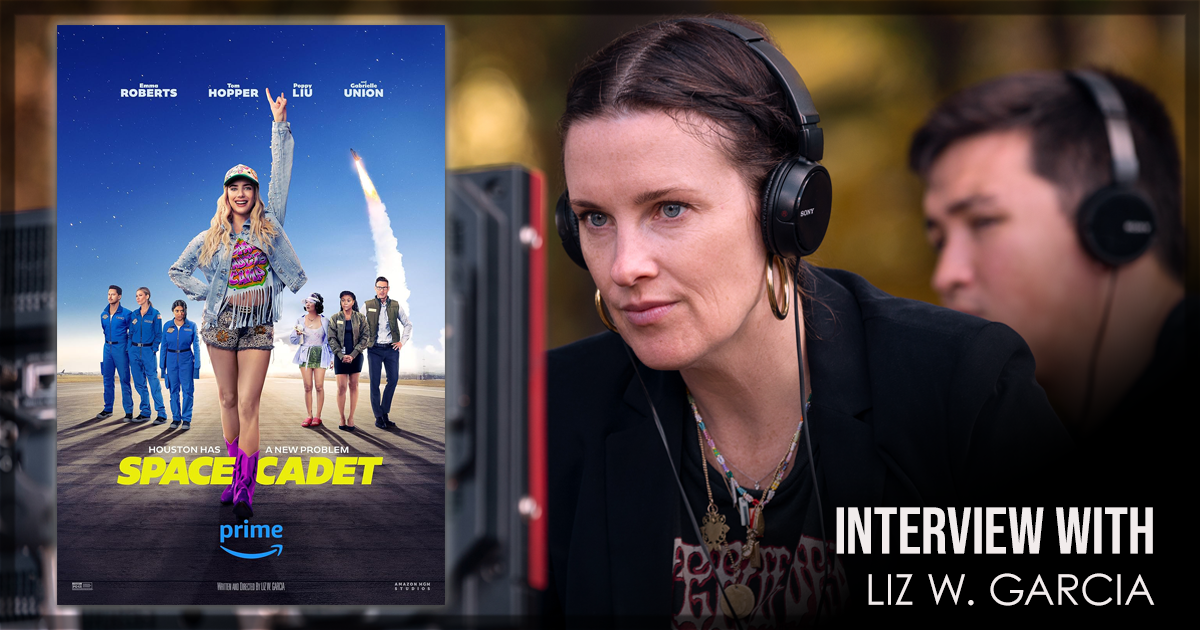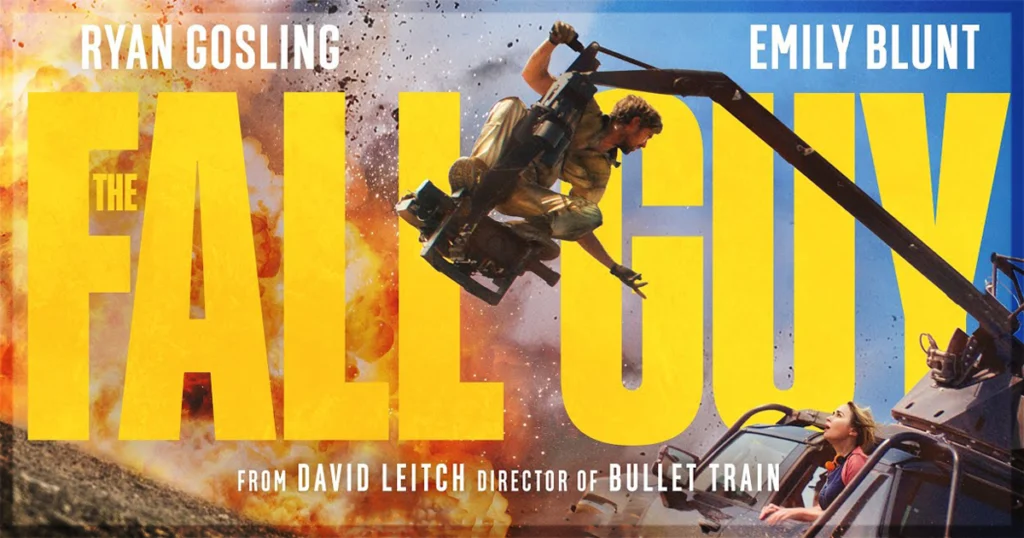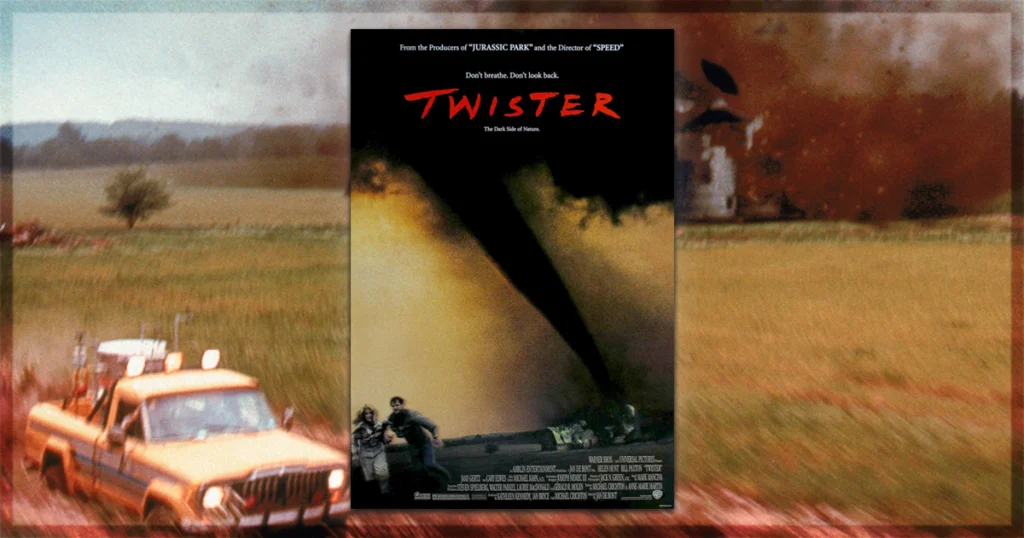Writer and Director Liz W. Garcia is the latest to take on NASA and space with her new comedy, Space Cadet. In the movie, Emma Roberts is Rex Simpson, a brilliant Florida bartender with big dreams among the stars. She doesn’t exactly have the resume of a typical NASA astronaut, but when her well-intentioned best friend Nadine (Poppy Liu) sends off an exaggerated list of credentials to the space program, NASA comes calling.
As she goes through the training, it turns out Rex is actually great at doing all the things you need to survive in space. After discovering what Nadine did, Rex has to keep her cover and keep from being found out by dreamy NASA Deputy Director Logan O’Leary (Tom Hopper) and mentor Pam Proctor, played by Gabrielle Union. There are hijinks and more, and ultimately, it all comes down to Rex to save her friends after disaster strikes.
The movie is hilarious and a ton of fun, so we were so excited to sit down and chat with Garcia over Zoom to find out everything that went into making Space Cadet. Garcia shared how the movie got going and started with a news article about an astronaut class finally having an equal ratio of men and women members. She talked about some of the movie’s big scenes – from simulating living on Mars to flying fighters- and detailed how they pulled them off. It was a great chat, and you can read all of it below.
The Interview with Space Cadet Writer and Director Liz W. Garcia
[Editor’s Note: This interview has been lightly edited for clarity.]
Ayla Ruby: I would love if you could talk about your journey to this project, just what made you want to write the story? What made you want to direct it? How did that all work?
Liz W. Garcia: Sure. So this is the third movie that I’ve directed. The first two were smaller, intimate, indie movies, dramas with some humor, but in the drama genre and small. And after I made the second one, I found that I went through some sort of inexplicable creative shift that I think just had to do with getting older. I can’t totally explain it, but it was like I made two movies where I felt like I was learning to use the medium to express a certain aspect of myself. And then when that was done, I wanted to use the medium differently. I suddenly wanted not just a bigger budget because I felt like I deserved to have what the boys were getting. That was a big part of it.
Liz W. Garcia: But also I think I was like, I want to not tell a story about myself or my life. I want to traffic in genre. I want to try to work within that paradigm. And so I was looking for something bigger and something comedic. I think it had taken a while for me to admit that maybe I was capable of comedy because I’m not… If I go to hell, it will be an improv class, not an extrovert in that way, and I think I therefore thought I couldn’t do comedy.
Liz W. Garcia: So it took a while to get to the point of admitting not only do I want to do it, but I think I can. So I was looking sort of casually open to what the idea could be. And NASA had a news article about how they had their first class of astronaut candidates where it was 50-50 male, female.
Liz W. Garcia: So that was a piece I was intrigued by and clicked on it and read it, and then was further intrigued by how incredibly accomplished these women were, these people were, started to read more about what was required to be considered. And the more I read, the more completely absurd it seemed, because you have to be so incredibly accomplished to even have them take your resume seriously. And I just started to love the idea of writing these roles of these very competitive, type A, accomplished, ferocious women. And I really wanted to see women in flight suits walking in slo-mo. Like it’s time, we deserve that.
Ayla Ruby: It’s almost The Right Stuff, but it’s Emma Roberts.
Liz W. Garcia: Yeah, they did it in The Right Stuff, they did it in Armageddon. I was like, “It’s time.”
On the movie’s development process
Ayla Ruby: So you obviously had this idea, you saw this article, it kind of influenced you. From that kernel, what was development like? How did that work?
Liz W. Garcia: This whole process making this movie has been so charmed. I kept waiting for the other shoe to drop, and it didn’t. My plan was to write Space Cadet on spec, attach myself to direct it, take it out to the market, hope it sold. But before I could do that, I was outlining it, and I had a meeting with Greg Silverman, who is the founder and CEO of Stampede, and I started to do the elevator pitch to him like, “Oh, here’s this thing I’m writing. Maybe eventually you’ll read it.” And he finished the pitch. He knew exactly what the movie was, he could see it, he was super excited, and he said, “We want to make this movie.” So then I wound up writing it for Stampede, and they got it going, they made the movie.
Ayla Ruby: That is awesome.
Liz W. Garcia: Yeah, yeah. I mean, they had to find financing, so that took a bit of time, but it was about three years from start to finish, which is nothing.
On Emma Roberts and Rex’s journey in Space Cadet
Ayla Ruby: It’s very fast. So Rex is obviously a really very interesting character, and I’d love to talk about her a little bit. If you could talk about her journey just through the movie, where she starts, where she ends, and just anything you can share on that.
Liz W. Garcia: Sure. Well, Rex is really designed to be the audience proxy, the fish out of water, the opposite of who you would expect at NASA, so really the opposite of a person who had ticked all the boxes, all the requirements. And I settled on this idea of a Florida girl because I was finding I had to design a character where she is qualified or she’s capable of being an astronaut. She just doesn’t have the resume, she doesn’t technical qualifications.
So I made her a mechanical engineer because then she could be doing this in her backyard, showing, living out her skills without a lab at MIT. And the journey for Rex is really about stepping into her dream, but like a lot of movies that have female protagonists, the largest arc is not the heroine’s arc. The arc is the world around her. So she’s incredibly competent, she’s a great leader, she’s a great teammate, and the major arc of the movie is this world that’s sort of hung up on resumes or qualifications coming to realize everything that she is and always was.
On the Mars module scene
Ayla Ruby: I love that. I think that’s a really interesting way of looking at it. I always think characters, but I love that. So there’s a lot of really cool things in this movie. Like you said earlier, there are some big things, and I’d love to ask about some of the specific things. So there’s this montage torture sequence, I guess, where they’re in the Mars module. It’s very high energy. And just from a filmmaking perspective, how did you pull that off? What was that like?
Liz W. Garcia: So there was always going to be this sequence that was part of their training that was based on one of the real training exercises the ASCANS have to go through, where originally the scene was based on how some of these ASCANS get dropped off in the Canadian Rockies and have to fend for themselves in sub-zero temperatures. And it’s so absurd and it’s so great because NASA’s always trying to find ways to expose the ASCANS to extreme environments where they have to work as a team and not lose their minds.
But that just was not possible for us from a production standpoint to be shooting in New Jersey and then somehow find our way to either Canadian Rockies or the desert or something like that. So instead I looked to another training exercise they do, which is making people live in a tent or geodesic dome on the side of a volcano where they have to basically pretend like we’re living on Mars, if you go outside, it’s Mars.
Liz W. Garcia: And I just thought that would be a great way to do some mix of The Real World meets The Lighthouse, the Robert Pattinson movie where everyone is just driving each other… We’ve all felt this with people that we live with where day one is fine and two weeks later, you actually want to commit homicide. So that’s what that was. It was the montage and the song, the pace, all of that was based on this idea of people becoming completely unhinged inside the dome.
On filming the big jet scenes in Space Cadet
Ayla Ruby: I can see The Real World influence now as I think back with the camera and stuff, so that’s fantastic. So there are a couple of fighter scenes, but towards the end, before this big reveal, there’s this really much larger fighter sequence. What was that like writing it? What was that like putting that into production, filming it? What can you share about any of that?
Liz W. Garcia: You mean the jet sequence?
Ayla Ruby: Yeah, the jet sequence towards the end where she’s piloting, and I won’t reveal much more.
Liz W. Garcia: Well, that was really a producorial feat pulling that off. My producer had to find this very particular jet because these jets that they use to train on are not civilian aircraft. Very few people actually own these. So then to find someone who owned it within the continental US, which my producer did find, who was then willing to not only fly it to us, to this private airport in New Jersey, but then be our stunt pilot.
Ayla Ruby: Wow.
Liz W. Garcia: So that sequence is a combination of the actors, Emma [Roberts] and Josh Harto playing her flight instructor in the jet itself, being taxied, being pulled around the runway or stationary with green screen behind them, and then the owner of the jet flying it. And we’ve set up cameras, teeny cameras inside the cockpit so that we could get the backdrop as the plane is going. Then we are outside on the ground with our cameras shooting the exterior of the jet. And that was nerve-wracking. There was no video feed, two little cameras inside the jet, so there’s no way of knowing how it works out until you get that back. You’re just praying and hoping for the best. And it all worked out.
Ayla Ruby: Was it like a one shot type of thing, or did you have a couple of chances to…?
Liz W. Garcia: A couple of chances, but this is all within the context of a twelve-hour shooting day. So there are only so many times you can do it. I think we maybe did it two or three times, and he was willing to make the jet look like it was being flown in a really wobbly amateur, willing to land it terribly, inexpertly.
Ayla Ruby: That’s fantastic. Yeah. I know we’re starting to get close on time, but I’d love to know, besides everything we’ve talked about, was there anything really challenging to pull off with this project or anything just super professionally gratifying?
Liz W. Garcia: It was professionally gratifying from start to finish. I think that I often enter professional experiences in Hollywood waiting to be treated poorly, assuming I’m going to have to prove myself, or assuming that in some way someone’s going to try to undermine me or underestimate me. And instead I was just surrounded by this incredibly respectful, supportive, delightful, cheerful, optimistic, wonderful team of people. It was really a dream experience. Even when things didn’t run smoothly, they were fine. No one was bad at their job, no one was cruel, and it was just really a dream, and so much fun, and we did a lot of laughing and it was great.
Ayla Ruby: Oh, that’s awesome. Well, thank you so much. This has been wonderful. And again, the film is lovely.
Liz W. Garcia: Oh, thank you so much, Ayla. It was really nice to talk to you.
Space Cadet streams on Prime Video on July 4, 2024.
Find out more about the film at the official website for the title.
You might also like…
‘The Fall Guy’ Movie Review: A Gleeful Action Spectacular
‘Twister’ Review: Reflecting on Amblin’s Best Disaster Film



